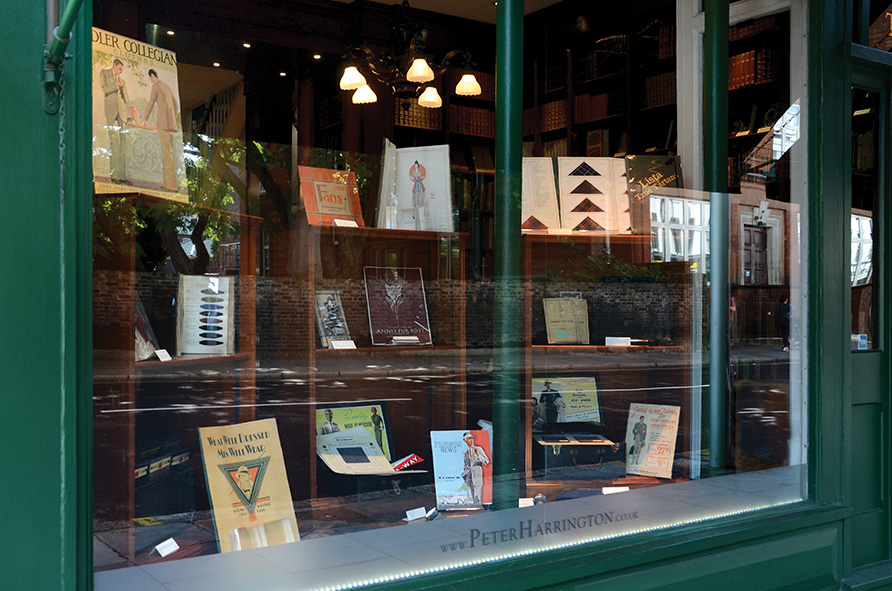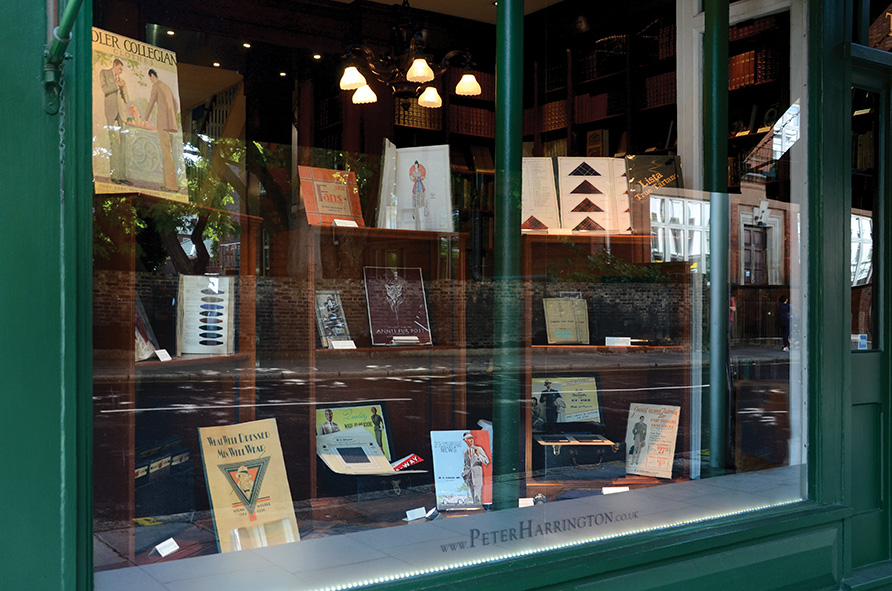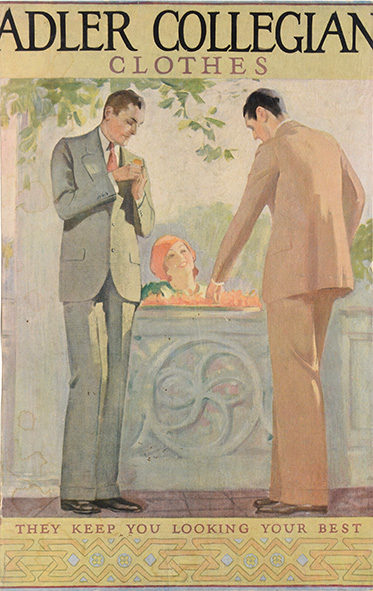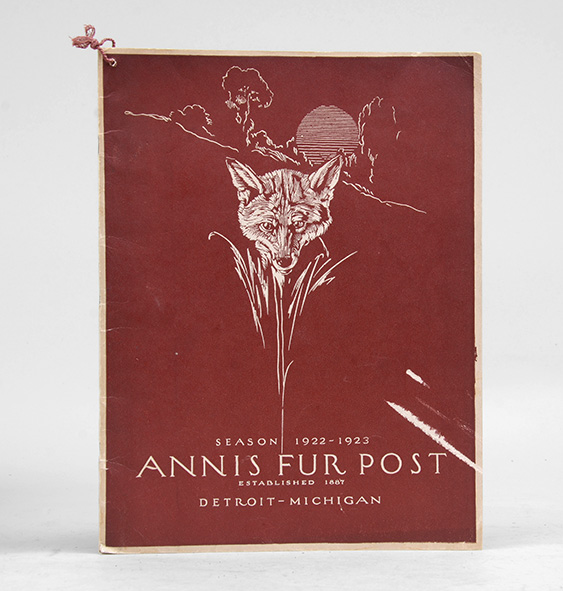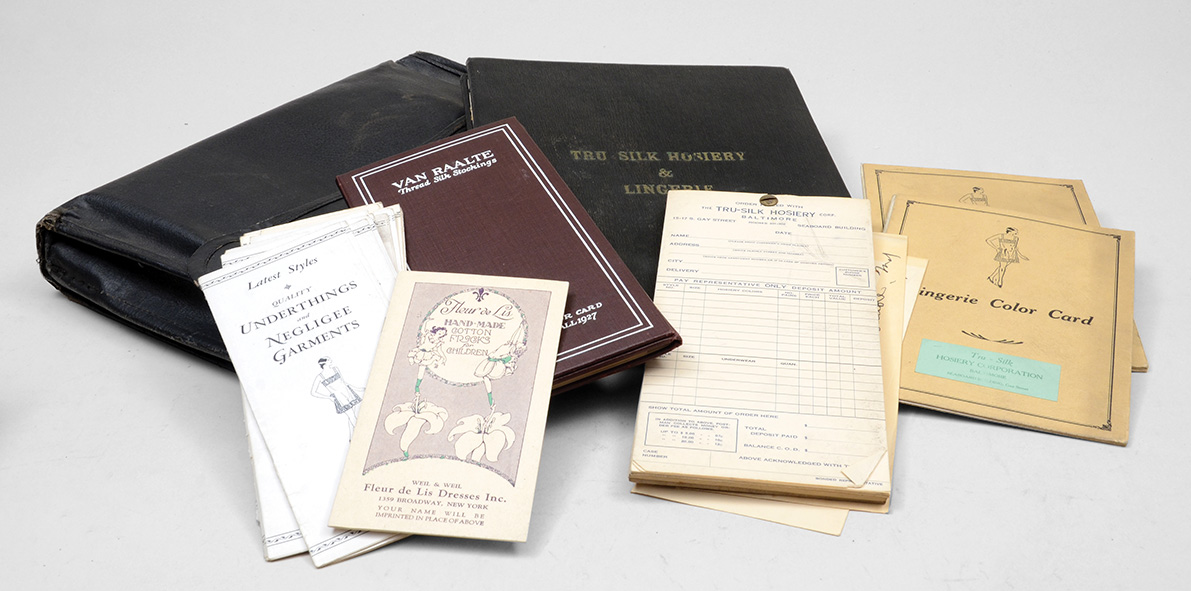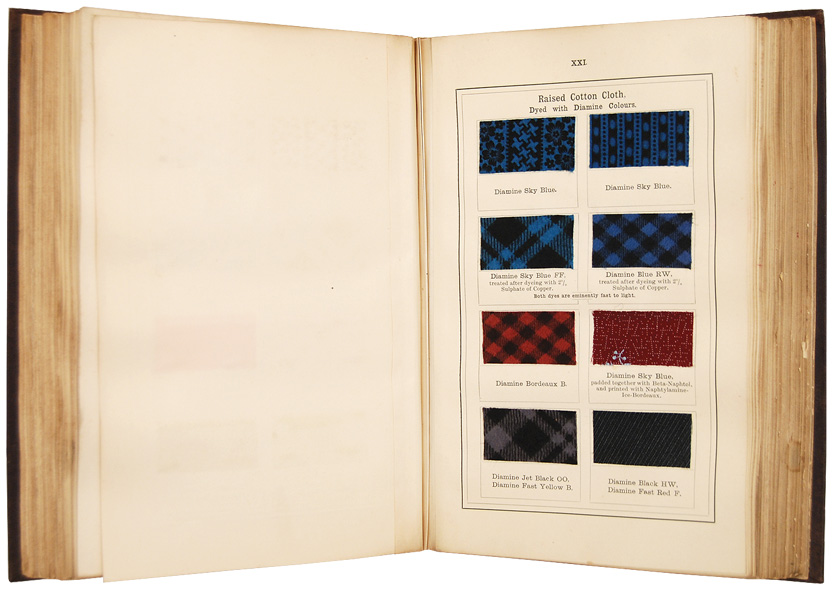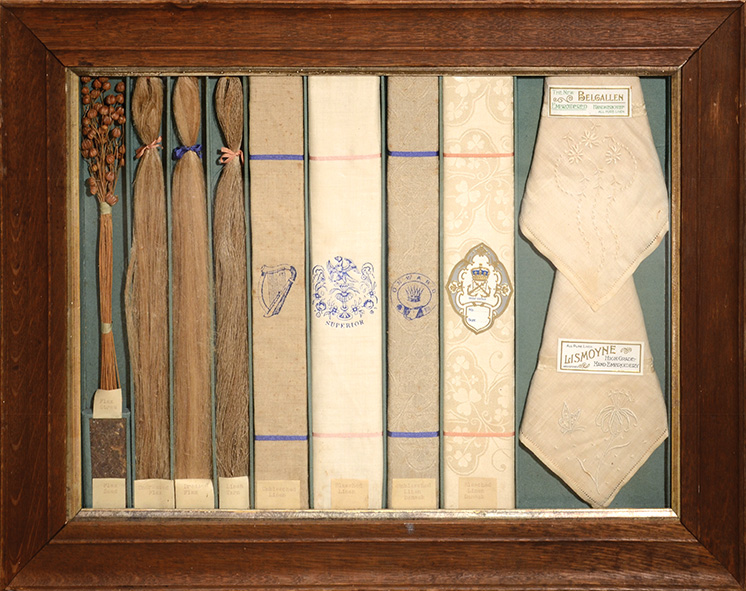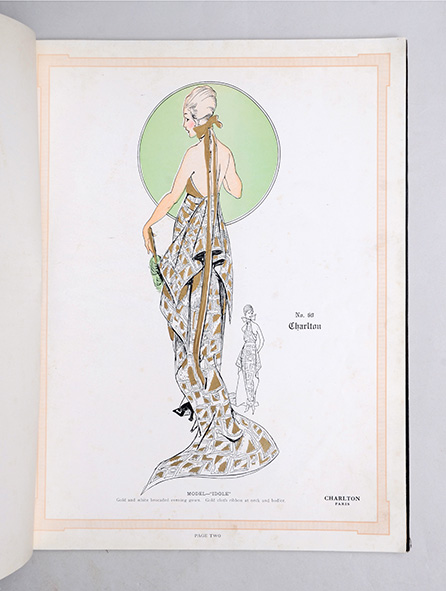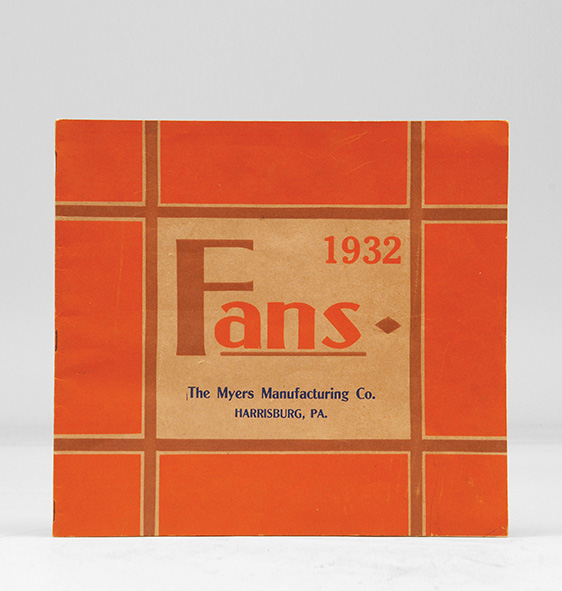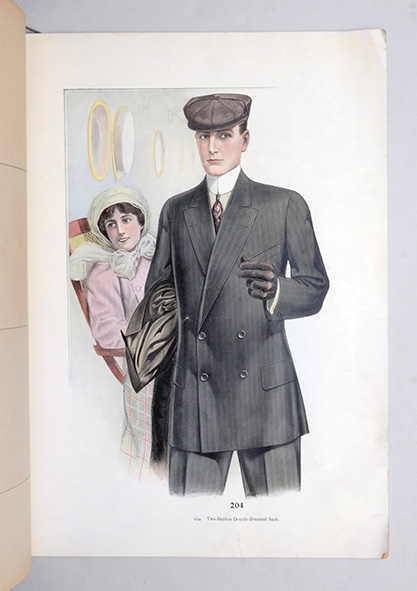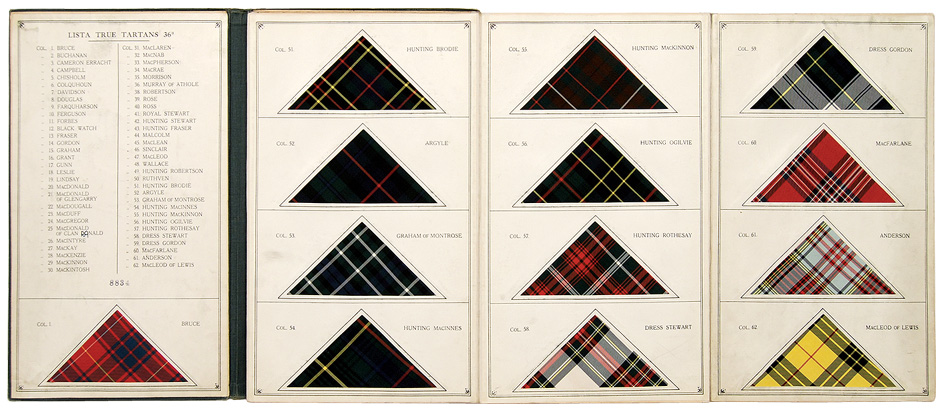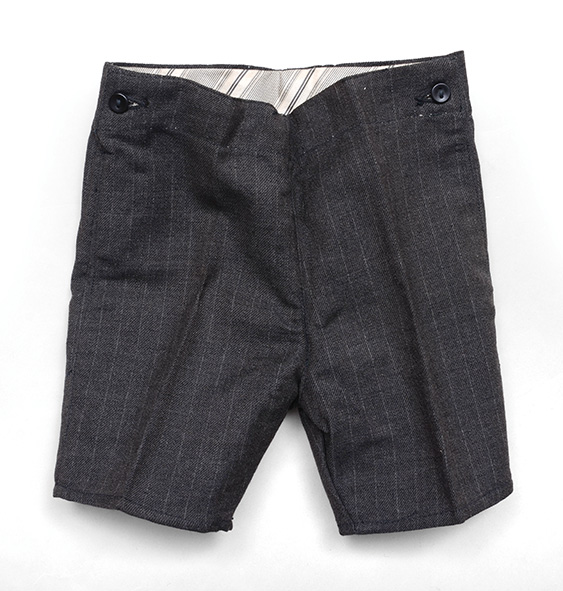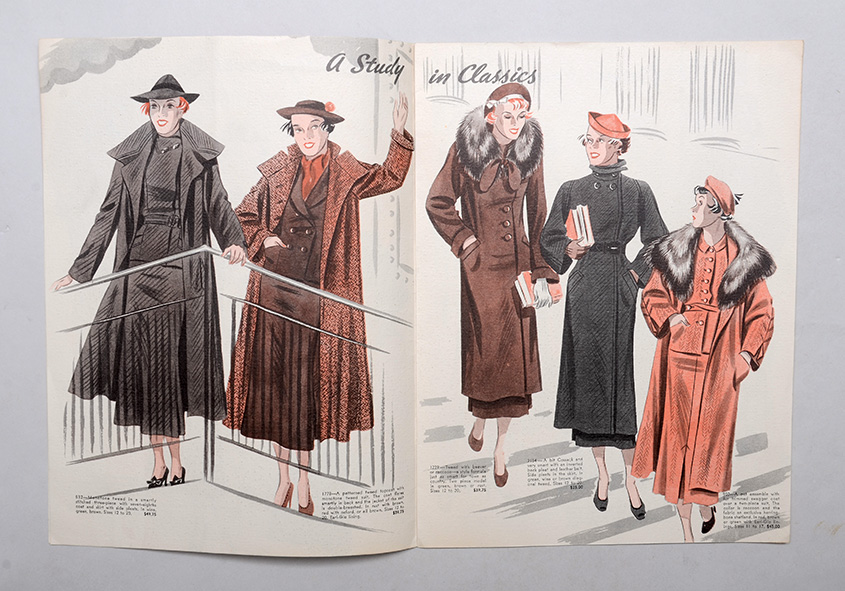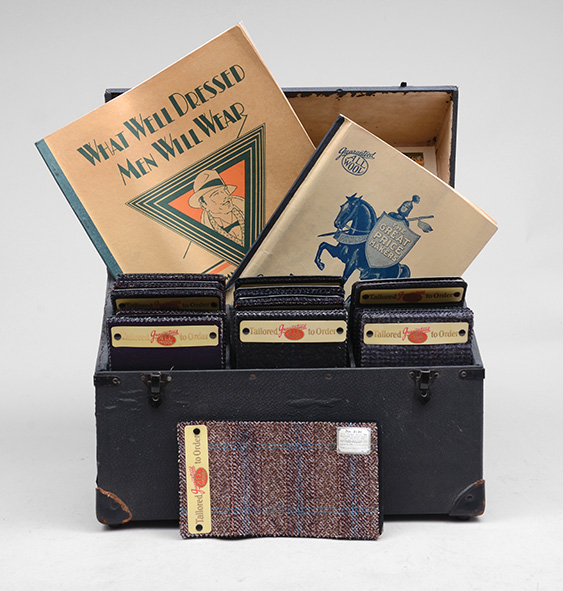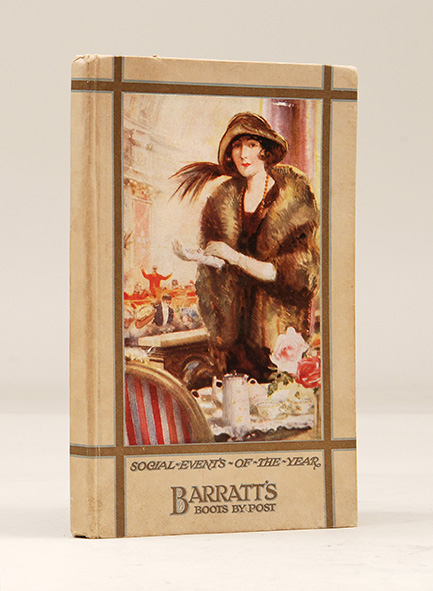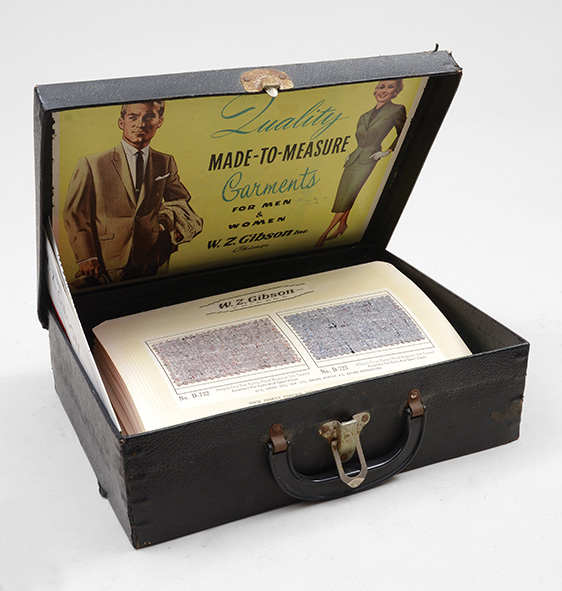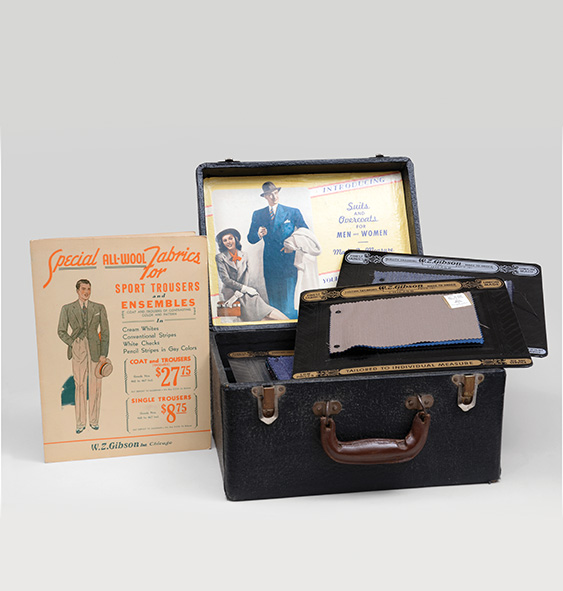Those who pass by our Fulham Road shop on a regular enough basis will already be aware that our window display changes frequently. Just in case you won’t have the chance to see it for yourself, we thought we’d keep you up-to-date on the books, prints and curiosities making an appearance each time a reshuffle takes place.
This week sees a superb collection of catalogues, sample books, shop displays and salesman’s kits from the world of fashion take pride of place in the window. Below you’ll find listings for each of the items featured; Should you wish to enquire further, you can simply email mail@peterharrington.co.uk or call us on 020 7591 0220.
Adler Suits Standee – “Adler Collegian clothes. They keep you looking your best.” Milwaukee, MI: Adler Company, c.1927
Striking counter display advertisement for the Adler Company “Collegian” men’s suits line, in a style reminiscent of the California Plein-Air School, with two sharp young men in Adler suits standing at a carved stone wall talking to a young beautiful co-ed in a jaunty orange hat. The “Collegian” line was aimed at college men, or anyone who cared about “perfect style with points of refinement”.
Although their advertising was not specifically collegiate, their advertising campaigns usually employed images that conjured idealised college associations, implying that the purchase of an Adler ready-to-wear suit, was the essential ante for success in college, business, and the all aspects of the appropriate middle-class lifestyle. This piece offers a beautiful example of Jazz Age aspirational advertising.
The Adler Company was founded in 1848 by Solomon Adler in Milwaukee, Wisconsin, and thrived through the Civil War, the Victorian era, eventually employing over 900 people, with nation-wide sales in the 1920s over $1.5m. During the Jazz Age the Adler Company became synonymous with their Collegian line. The company was liquidated after the crash in 1929. (Daniel Clark, Creating the College Man, American Mass Magazines and Middle-Class Manhood, pp. 165-168; and Historic Designation Study Report, Emanuel D. Adler House, pp. 5-6).
£200
Annis Fur Post, Season 1922-1923. Detroit: Newton Annis, 1922
Uncommon trade catalogue for fashion fur – coats, capes, scarves, hats, and muffs for the Jazz Age. The types of fur include chinchilla, ermine, monkey, mink, fur seal, leopard, white fox, beaver, marmot, civet and caracul.
Annis Fur Post was founded in 1887 by Isaac Newton Annis (1858-1939), who had started collecting furs around his home in southern Michigan as a young man. In 1880 he was employed by Frederick Buhl and Company, a Detroit fur pioneer, in the manufacturing department, and remarkably by August 1887, on a capital of less than $1000, Annis started in business for himself with four employees. By the 1920s he had over 120 employees and was a major supplier to the American fashion trade. The business continued successfully until the 1980s when changing tastes forced scaling back, and eventual closure. This beautifully produced catalogue is highly evocative the oh-so, luxurious and stylish 20s.
£225
The Tru-Silk Hosiery Corporation, Baltimore. Commission Salesman’s Kit. Baltimore, MD: The Tru-Silk Hosiery Corp., 1927-7
Black leather-textured cloth briefcase, nickel plated turn clasps, leather handle, internal divider into two sections, and front pocket. Containing quarto black-cloth, brass-post binder catalogue with 24 pages illustrating women’s lingerie fashions with half-tones from photograph, large textile sample card with 24 silk sample colour-chart; three fold Van Raalte silk stocking sample catalogue in burgundy cloth, lettered in white, with 24 textile samples, and tear-away order form; two 2 card leaf lingerie fabric and colour sample catalogues, each with swatches of Milanese, rayon, crepe de chine, and glove silk, and 14 colour fabric samples, Tru-Silk label on front cover; 12 accordion-fold give-away catalogues for lingerie, some duplication, some with colour or price annotation; unused order pad, brass screw retainer, heavy card back – annotated with a customer list – with two pre-addressed pre-paid return envelopes. The case a little rubbed, contents slightly used, but overall very good.
From the Aladdin Rosenbacher estate in Winston-Salem, NC. The Rosenbacher & Brothers department store was one of the earliest, largest, and most fashionable in the region, opening in 1880. Aladdin Rosenbacher inherited the famed Rosenbacher House, considered one of the most beautiful neo-classical revival houses in Winston-Salem, and lived there until his death in 1975. This is an unusually complete salesman sample case and includes a superb photographically-illustrated catalogue, highlighting the lingerie trends of the Jazz Age; the movement away from the constraint of corsetry, offering cuts that “give extreme freedom of action” and concealment beneath the more fluid dress shapes of the 20s, and “Shorties – The New Smart and Fastidious Vogue of New York and Paris – Featuring Popular Dance Sets in Dainty Designs”. The colour and fabric choices also mirror the latest fashions emerging from the Paris houses of Chanel, Lanvin and Poitou. A group that offers invaluable illustrated reference for the colours, styles, and fabrics during the Flapper era.
£450
KERTESZ, A. (ed.), The Diamine Colours of the Aniline Colour Works of Leopold Cassella & Co., Frankfort-o.-M. Their Properties and their Application in Dyeing and Printing. Frankfurt: Leopold Cassella & Co., 1895-6
Large octavo (249 × 164 mm) Original sand- and morocco-grained cloth, title gilt to spine, gold patterned endpapers. Double frontispiece of the company’s works, hundreds of mounted fabric samples, some folding sheets. Suned at the spine, a little rubbed, very slighty splitting on the joints, folding leaves a bit dusty, a very good copy.
First and only edition, uncommon, just 10 copies on OCLC. Cassella were the foremost producers of these aniline dyes in the late nineteenth century, in 1925 they became part of IG Farben. “We publish this book with the object of assisting our customers when working with the Diamine Colours, having regard to the variety of uses to which they are now being put in the different branches of the dyeing and printing trades.” (Introduction) The samples show the action of the dyes on a wide range of fabrics, cotton, wool, wool-cotton mixes, silks and others.
£400
Edwardian linen manufacturer’s shop display.
Glazed oak-framed display case (419 × 546 × 32 mm). Divided into compartments, green felt-covered background and dividers; the 10 compartments show the stages of linen production from seed through straw and yarn to the finished textile; 6 large samples, unbleached and bleached, linen damask, and finished embroidered linen handkerchiefs; each compartment neatly labelled with typed slips; some of the samples featuring stamped designs, an Irish Harp, a crown encircled by a belt, an eagle with vase and floral decoration; two with floral embroidery and printed, embossed and gilt labels for the Belgallen and Lismoyne linens. Minor dust-soiling and slight darkening to samples under glass, frame just a touch rubbed, backing renewed.
This scarce and unusually complete Edwardian point-of-sale display promoted the popular, mid-range Belgallen and Lismoyne linen lines. Demonstrating the quality of raw and finished product, the case shows flax seed in a small sealed compartment, flax straw, undressed flax, dressed flax, linen yarn, and finally finished handkerchief samples. While making much of their Irishness it is possible that these were in fact American brands.
Newspaper advertising of the period shows these handkerchieves carried by department stores across America—D. F. Groves “Ladies’, Misses’ and Children’s Toggery” in the Manchester Democrat, Iowa, offering them “None better, few equal” in December 1913; two years later The Kaufmann store advertising in the Richmond Times Dispatch; “Lismoyne Handkerchiefs of sheer linen. The painstaking care of expert needlewomen is shown in every one. Scores of designs”; and in the same year Benison’s (The Ideal Gift Store) drew attention in the Iowa City Daily Press to “Bengallen and Lismoyne Hand Embroidered Linen and Shamrock Lawns—in every new Handkerchief Idea”.
£750
Fall & Winter model gowns displayed by the Charlton Company.Openings New York, Waldorf Astoria. Chicago, Auditorium Hotel. Paris, 43 rue de L’Echiquier … Chicago: Charlton Company, 1919
First edition of this uncommon and stunning fashion catalogue for evening gowns at the dawn of the Flapper Era. The Charlton Company organized shows of the latest Paris fashions in Chicago and New York, providing designs and inspiration for garment manufacturers, textile companies, and showcase the trends for the coming season. Each plate illustrates a gown with a coloured front view, and a line remarque of the back detailing, occasionally with suggestions for accessories. Brief caption texts provide fabric and detail notes.
This is the last of the Charlton catalogues to be illustrated with these stylish, hand-finished plates, later issues containing rather crude half-tones. Remarkably this handsomely produced catalogue was published just a year after the end of World War I, it includes two of Gabrielle “Coco” Chanel’s highly influential early designs, and one each from Paul Poiret, Worth and Lanvin. But the traffic in ideas was not one way, the majority of the designs gathered here are from the Fashion Art League of America, founded in 1904 to promote the American textile and garment industries.
£575
Fans – 1932. Harrisburg, PA: The Myers Manufacturing Co., 1932
Spectacular trade catalogue featuring the vivid pictorial fans produced by the The Myers Manufacturing Co., a Pennsylvania novelty company founded by Dr. L.B. Myers, the first man to patent rubber tips for pencils. Myer’s fans were essentially an advertizing medium commended for their “distinctive appearance – large advertising space – compactness”, and insert offers “Suggested Copy for Fan Advertisements”. The subject matter of the images is unashamedly populist, sentimental, and even religiose – “Guarding his flock”, Christ with sheep – that of “Colored Mother and Child” is described as “An unexcelled medium for the advertiser who serves the race.” A quite extraordinary survival.
£175
Schoenbrun & Company, Merchant Tailors. Latest Fashions – Fall and Winter, 1911-12. Chicago: Schoenbrun & Company, 1911
Superb Edwardian fashion catalogue for men’s suits, leisure suits, and evening wear. The colour lithography in this catalogue beautifully executed, and very striking visually. Although the artwork is unsigned, it reflects the influence of Harrison Fisher, Howard Chandler Christy, and other famed illustrators of the period. The backgrounds include men in suits with fashionably dressed Edwardian women, on the Ocean Liner deck, next to a brass-lamped automobile, in front of Pullman Railroad Cars, even one showing a man in vest and slacks changing a tire on an automobile.
The catalogue offers such styles as the Sack Coats with more closely fitting waist & back, trowel shaped labels, and natural shoulder; frock, full dress and Prince Albert Coats; the Tuxedo, as well as vests overcoats, trousers, and more. The Schoenbrun Company was noted for their high quality fabrics, including Harris Tweeds, West of England and Belgian Wide Wale Worsteds, Coronation Cheviots, as well as domestic wool blends of Knickerbocker Tweeds, Hockanums, chevron stripes and worsteds, and more.
The Schoenbrun Company was perhaps best remembered for their annual promotion urging men to come in and be measured for their Easter Suit which continued up until World War I. No copies located on OCLC. The versos of some plates ruled in pencil, with the lyrics of popular songs of the period – A Long Way to Tipperary, and When you wore a Yellow Tulip, being two of them – neatly pencilled onto three by a young Nellie Lee of Stanton, Michigan, whose ownership signature is on first leaf.
The catalogue is accompanied by Nellie’s extensive collection of “paper dolls”, figures painstakingly trimmed from the fashion plates of catalogues and magazines, and previously housed in envelopes between the pages of the present catalogue.
£850
Lista True Tartans – All British.
Wonderful sample books for “true” tartans, that is fabrics woven with accurate thread counts to match the approved sett or pattern for recognized clan tartans. A total of 146 identified tartans are represented by fabric swatches, rectangular in one volume, triangular in the other, both of around six inches in length so we presume that the full sett is shown in the examples.
Lister’s Manningham Mills, based in a superb high Victorian Italianate building with campanile-chimney, was the largest silk factory in the world, at its height employing 11,000. They were suppliers of highest quality fabrics, for example providing 1,000 years of velvet for George V’s coronation. With the rise of foreign competition, and the prevalence of artificial fibres the business collapsed in the 1990s, the Grade II* listed building has been renovated and converted into apartments.
£450
Marx & Haas Clothing Co. – pinstriped baby trousers. St. Louis, Mo.: Marx & Haas Clothing Co., c.1916
Original card box with tray lid (154 × 201 × 23 mm), containing a baby-sized pair of grey pinstriped trousers. Illustration on the lid shows an angel delivering a baby to a little house on the prairie, captioned “May the ‘Sonshine’ ever fill your home”; sides of the box-lid lettered “Marx Made” and the slogan in the bottom of box reading “More Than A Million Men Wear – Marx Made Clothes”. Minor damage and soiling to the box, but overall very good.
A wonderful promotional item, featuring button sides and a fully-lined waistband. Evidently sent to the proud parents of baby boys in the hope that they would look kindly upon the makers of their son’s “first pair of pants.” The company was founded in 1855, and in 1902 in his summary of Mercantile, Industrial and Professional Saint Louis, Ernst Kargau described the company’s output as enjoying “an enviable reputation among dealers as well as consumers.
Trousers are a speciality of the firm … and every garment is warranted to give perfect satisfaction. They are made up under the supervision of experienced tailors and every piece is closely examined before it leaves the shops. Twenty-two travelling men attend to the sale of the immense output, the average of which may be imagined from the fact, that much more than a million garments were sold in 1901. The territory of sales embraces almost every part of the Union” (p599). Unusual and attractive.
£75
On’n off the Campus. Seattle: Frederick & Nelson, 1935
Wonderfully illustrated fashion catalogue for college girls, including classics for classes, trim woollens, silk dresses, evening fashions, and even fur coats. The “Cheer Leaders” pages which offer a range of fur-trimmed coats for the football game, features a full schedule for college football in the Far West. Frederick & Nelson had been purchased by Marshall Fields in 1929, and during the 1930s was the fashion destination for the Pacific Northwest. Unusual and appealing.
£45
Chicago Wollen Mills Co. Saleman’s Fabric Sample Case.
Chicago: Chicago Woolen Mills Co., 1929
Wooden sample case (320 × 442 × 180 mm) black leather-textured cloth-covered wooden case, with hinged lid cut on the slant, leather handle, black japanned clip-clasps, lower corners with leather protectors, metal brackets reinforcing jonts at rear of lid, and front of case; interior divided with one long section holding a catalogue and the order book, and six small “pigeonholes”, each with three fabric sample cards; interior of lid with mounted paper banner strip – “Quality: In Fabric – In Workmanship – In Style”.
Folio catalogue, “What Well Dressed Men Will Wear: Autumn/Winter 1929-1930”, wire-stitched in manila card wraps with green cloth reinforcing strip at the spine, stylish two-colour printed – orange and bottle green – cover design, 14 coloured plates and 2 monochrome; quarto order book, wire-stitched in light card wraps printed in blue with black cloth reinforcing strip at the spine, unused, carbon paper still in place, detailed measurement sheets; 18 sets of cloth samples, mounted on textured card each with an ivorene label – “Gauranteed All Wool – Tailored to Order” – over 120 swatches each with a paper label with detailed descriptions of composition and pattern; two price lists, one a double-sided singlesheet printed in black and blue, the other a 4-page listed, wire-stitched in light card wraps, “Dealers’ Confidential Wholesale Price List”; 3 unused return envelopes printed in red.
Case a little rubbed, soiled and with mild damping, cockling the cloth, on one corner of the lid, but overall the case and contents are very good.
£1,250
W. Barratt & Co. Ltd. Social Events of the Year – Barratt’s Boots by Post. Northampton: W. Barratt & Co. Ltd., 1923
Attractively produced, fully priced catalogue from Barratt’s, the long-established Northampton shoemakers. Themed around the social calendar, with coloured plates of events such as Henley, Ascot, and the motor Show at Olympia, together with images of the Barratt factory, line-drawn illustrations of their retail outlets, and a fully illustrated catalogue of their range of footwear – from football boots, “solid blocked toe, roomy front”, to the “Smart Tango Shoe – excellent quality brocade pump sewn.”
£175
W.Z. Gibson, Inc. Spring ad Summer 1960 – Salesman’s Sample Box. Chicago: W.Z. Gibson, Inc., 1960
Original black cloth-textured cloth covered card “attaché” case (328 × 250 × 90 mm), plastic handle still in place, and tin snap-clasp, lid lined with colour-printed ad.; “Quality Made-to-Measure Garments for Men & Women”. Contains; quarto catalogue, “Fashion News”, wire-stitched colour card wraps, colour printed throughout; 68 printed cards with 113 of 116 cloth samples, 3 cards lacking one of two; price lists, order forms, and associated promotional material. Case a little worn, but remains very good, as also the contents.
W.Z. Gibson Inc. was one of the largest franchise tailoring companies in America, here in the 1960s probably at its peak. An attractive, and complete, salesman’s kit.
£500
W.Z. Gibson Inc. Salesman’s Sample Case, 1935. Chicago: W.Z. Gibson Inc., c.1935
Wooden suit-case style wooden sample case (267 × 345 × 190 mm), covered in textured black cloth, metal hinged lid, retaining original latches and handle. Coloured illustration mounted inside the lid – “Introducing Suits and Overcoats for Men and Women – Made-To-Measure. Your Choice of Material and Style”: box contains double-fold, colour-printed brochure on light card stock, “Special All-Wool Fabrics for Sport Trousers and Ensembles”, with eight mounted fabric swatches, and 19 embossed and gold- or silver-printed swatch-cards with over 130 mounted fabric samples. Box superficially rubbed, contents clean and very near complete – one swatch seems to have been cut away from a card – but the box still contains the original inspector’s number – overall very good.
An excellent example of the promotional material provided for the sales force recruited by W.Z. Gibson, one of the leading exponents of the American “mail order made -to-measure” tailoring industry – the captioning on the swatch-cards reads; “Low Prices – Tailored to Individual Measure – Six Day Service.” Around this date the company were advertising for salesmen in Popular Science with the pitch, “Make $100 Weekly selling better-quality, all-wool, tailored-to-measure suits … Extra bonus for producers. Over 100 6 × 9 swatch samples furnished”, and indeed there were. The brochure includes some spectacular examples, coat and trousers offered at $27.75 in the Henrietta Fine Grade Cream White Self-Check Gabardine Two-Ply Worsted, or the Real Swell Hockanum Hellebore-Green Striped Two-Ply; trousers at $8.75 in Hockanum Very Fine Weave Silk-Decorated Duotone Stripe Two-Ply Worsted, or perhaps the Botany’s Fine Grade White Flannel.
£725

